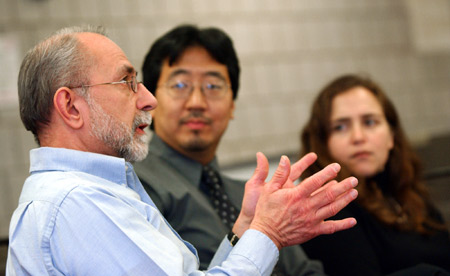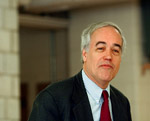School’s diversity mirrors world’s
Civil Rights Project Study puts numbers to the benefits of diversity

Exposure to students of several racial, ethnic, and economic groups is preparing Cambridge Rindge and Latin students well to face an increasingly diverse working world, according to a new Harvard Civil Rights Project study released Tuesday (Jan. 29).
According to the survey of the high school’s seniors, 79 percent believe their school experience “helped a lot” or “helped somewhat” in their ability to work with members of other races and ethnic groups. Similarly, 95 percent said they were “comfortable” or “very comfortable” working in groups with students from different racial and ethnic backgrounds.
“Cambridge Rindge and Latin is producing young people prepared to work in diverse settings in the real world,” said Civil Rights Project Co-Director Gary Orfield. “This high school and the integration process in Cambridge has been a powerful plus.”
The study, released at a news conference at the school, is an effort to direct attention onto school diversity at a time when schools in the United States are becoming increasingly segregated, Orfield said. The study is particularly important because school racial makeup is rarely part of today’s education debate, which focuses on reading and writing.

“We are re-segregating our schools. There’s little leadership on this issue,” Orfield said. “Most of the discussion on education in the U.S. is on math and reading scores, but we didn’t establish public schools for math and reading, we established them to build a nation.”
An important part of building a nation, Orfield said, is creating citizens who are not only educated, but who can live and work together. Cambridge is a good community to examine, Orfield said, because it contains considerable diversity within its borders. Not only does it have several different ethnic groups, including white, African American, Latino, and Asian, it also has a range of economic groups, from the very poor to the very rich. With just one high school serving the entire community, all those groups come together at Cambridge Rindge and Latin.
Cambridge is the second of several communities across the country in the Civil Rights Project’s study, including Louisville, Ky., and five other districts whose survey results haven’t been announced. Orfield credited research assistants John Yun and Michal Kurlaender with doing critical work on the project.
The survey was conducted independently of city and school officials, but done with their permission. It consisted of a 70-item questionnaire, given last year during school hours. All seniors present were required to complete it.
Cambridge officials hailed the survey’s results, saying it vindicates the inclusive approach they’ve taken for years. Mayor Michael Sullivan said it’s particularly gratifying that the approach is being noticed by those who can most benefit from it: the children.
“The richness of this community is something we’ve always celebrated,” Sullivan said. “The beauty of this report today is that it shows the diversity we have in Cambridge has been recognized by others — the kids — who say it has improved their lives.”
Cambridge School Superintendent Bobbie D’Alessandro said she was gratified to see that the high school students feel they’re respected, by each other and by teachers. D’Alessandro said she believes that Cambridge can be a model for the nation in how it handles issues of integration.
Other results of the survey showed that issues of race are discussed quite often, with 81 percent reporting that the issues are explored between one and three times a month. Forty percent of students responded that the discussions changed their understanding of differing points of view on the issue.
One problem area the survey identified was the extent to which counselors have encouraged students to take honors or advanced placement classes, with 53 percent of the total responding they had been “somewhat” or “strongly” encouraged. The racial breakdown of responses, however, shows that 75 percent of Asians and 66 percent of whites responded that they were strongly or somewhat encouraged to take those courses, versus just 43 percent of African Americans and 36 percent of Latinos.
Orfield said the result highlights a “serious issue” that researchers have already discussed with school staff, who are committed to addressing it.
Leonard Solo, Cambridge Rindge and Latin’s interim principal, said the survey shows what many there already knew — that diversity is working in the school. Still, he said, the staff is committed to work harder to address any areas shown by the survey to need improvement.
“(The survey) really validates what we’ve experienced here on a daily basis. We really believe diversity is good. It’s really the best starting point for learning,” Solo said. “We’re at a crossroads in this country. We can serve as a model for other schools.”
Contact Alvin Powell at alvin_powell@harvard.edu




